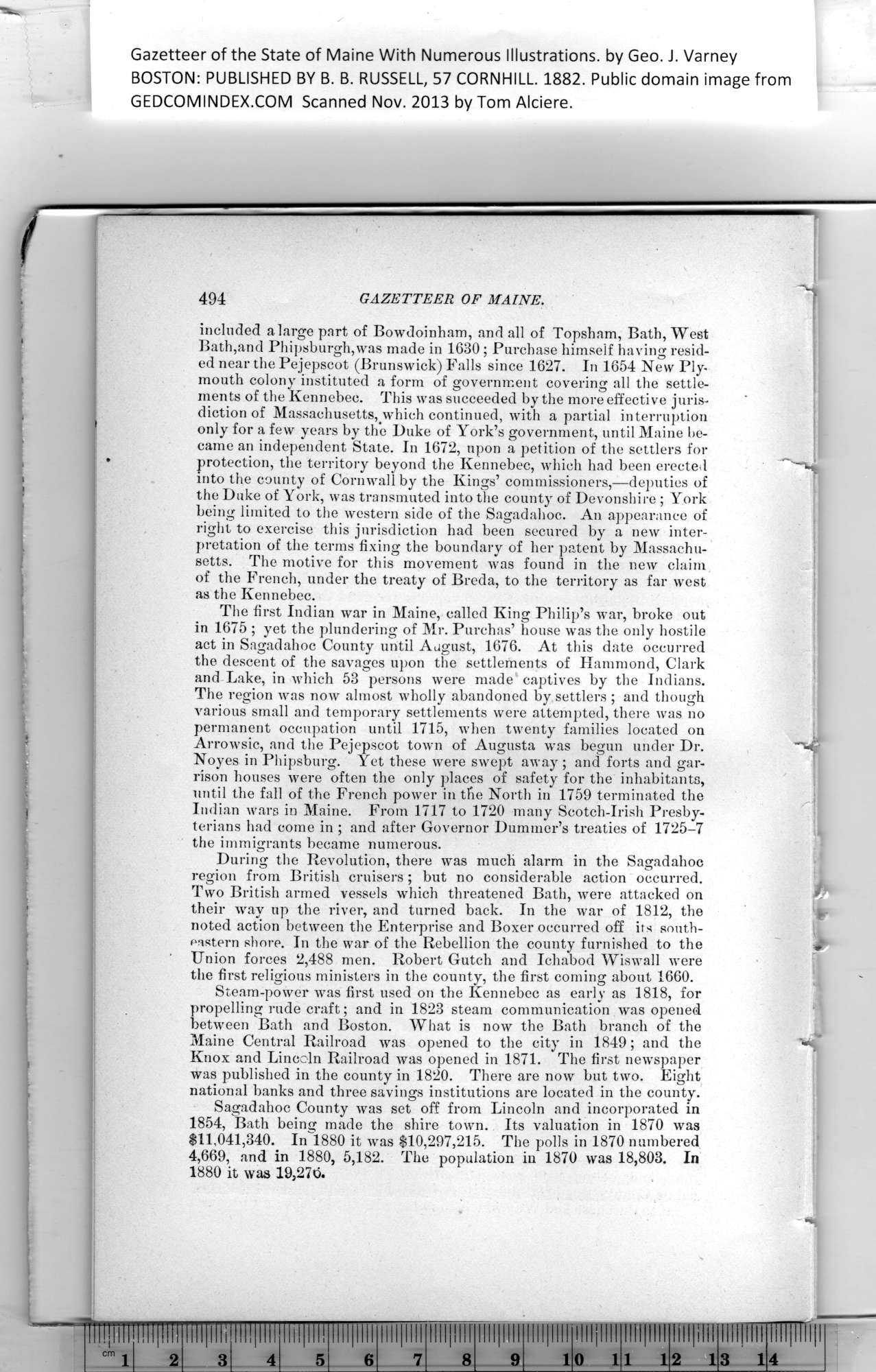|
Gazetteer of the State of Maine With Numerous Illustrations, by Geo. J. Varney
BOSTON: PUBLISHED BY B. B. RUSSELL, 57 CORNHILL. 1882. Public domain image from
494 GAZETTEER OF MAINE.
included a large part of Bowdoinham, and all of Topsham, Bath, West
Bath,and Phipsburgh,was made in 1630 ; Purchase himself having resid-
ed near the Pejepscot (Brunswick) Falls since 1627. In 1654 New Ply-
mouth colony instituted a form of government covering all the settle-
ments of the Kennebec. This was succeeded by the more effective juris-
diction of Massachusetts,which continued, with a partial interruption f
only for a few years by the Duke of York’s government, until Maine he- '
came an independent State. In 1672, upon a petition of the settlers for
protection, the territory beyond the Kennebec, which had been erected
into the county of Cornwall by the Kings’ commissioners,—deputies of L
the Duke of York, was transmuted into the county of Devonshire ; York
being limited to the western side of the Sagadahoc. An appearance of
right to exercise this jurisdiction had been secured by a new inter-
pretation of the terms fixing the boundary of her patent by Massachu-
setts. The motive for this movement was found in the new claim
of the French, under the treaty of Breda, to the territory as far west
as the Kennebec.
The first Indian war in Maine, called King Philip’s war, broke out
in 1675 ; yet the plundering of Mr. Purchas’ house was the only hostile
act in Sagadahoc County until August, 1676. At this date occurred
the descent of the savages upon the settlements of Hammond, Clark
and Lake, in which 53 persons were made captives by the Indians.
The region was now almost wholly abandoned by settlers ; and though
various small and temporary settlements were attempted, there was no
permanent occupation until 1715, when twenty families located on ,
Arrowsic, and the Pejepscot town of Augusta was begun under Dr.
Noyes in Phipsburg. Yet these were swept away; and forts and gar- *
rison houses were often the only places of safety for the inhabitants,
until the fall of the French power in the North in 1759 terminated the ;
Indian wars in Maine. From 1717 to 1720 many Scotch-Irish Presby-
terians had come in ; and after Governor Duminer’s treaties of 1725-7 *
the immigrants became numerous.
During the Revolution, there was much alarm in the Sagadahoc
region from British cruisers ; but no considerable action occurred. .
Two British armed vessels which threatened Bath, were attacked on
their way up tbe river, and turned back. In the war of 1812, the
noted action between the Enterprise and Boxer occurred off its south-
eastern shore. In the war of the Rebellion the county furnished to the 4
Union forces 2,488 men. Robert Gutch and Ichabod Wiswall were
the first religious ministers in the county, the first coming about 1660.
Steam-power was first used on the Kennebec as early as 1818, for
propelling rude craft; and in 1823 steam communication was opened
between Bath and Boston. What is now the Bath branch of the
Maine Central Railroad was opened to the city in 1849; and the
Knox and Lincoln Railroad was opened in 1871. The first newspaper
was published in the county in 1820. There are now but two. Eight
national banks and three savings institutions are located in the county.
Sagadahoc County was set off from Lincoln and incorporated in
1854, Bath being made the shire town. Its valuation in 1870 was
$11,041,340. In l880 it was $10,297,215. The polls in 1870 numbered
4,669, and in 1880, 5,182. The population in 1870 was 18,803. In
1880 it was 19,276.
PREVIOUS PAGE ... NEXT PAGE
This page was written in HTML using a program written in Python 3.2
| 